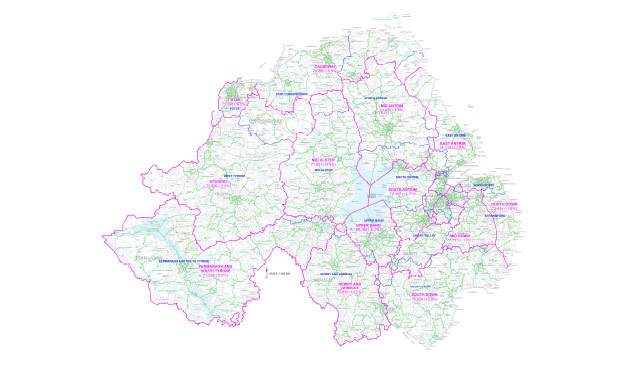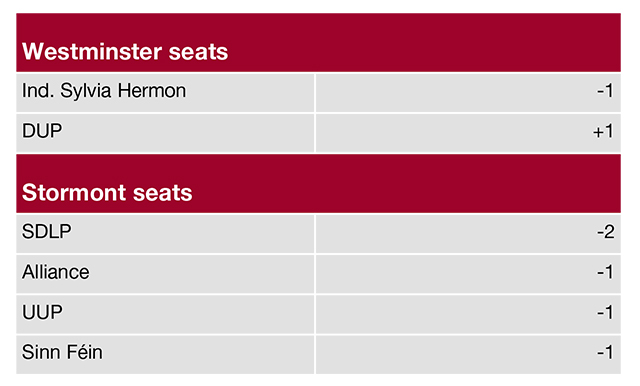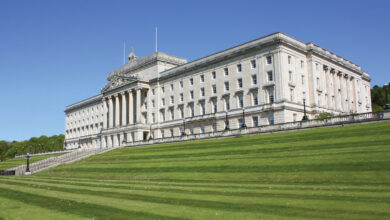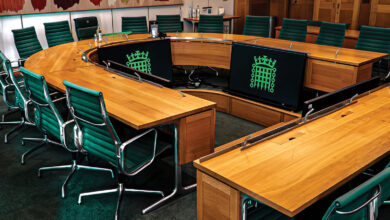Know your boundaries


An overall plan to reduce the number of MPs in Westminster from 650 to 600 has seen several proposals which would see Northern Ireland’s current number of electoral constituencies reduced from 18 to 17. The changes come after a lengthy consultation process dating back to 2013. agendaNi reports.
Going through changes
The proposals, published in September, will see the constituencies of Foyle and Fermanagh and South Tyrone relatively unchanged. Four new constituencies will be created: Causeway, Mid Antrim, Mid Down and Sperrin. 11 will retain their original names, yet their boundaries will be altered: East Antrim, Belfast, Newry and Armagh, Mid Ulster, South Antrim, North Down, Upper Bann and South Down. Previous proposals to introduce Glenshane and Dalriada constituencies have been abandoned.
Five constituencies will be removed from the boundary map due to a lack of replacement in the final proposals. The plan would see North Antrim, Lagan Valley, Strangford, East Londonderry and West Tyrone disappear, in what would represent a shift from the former proposals which suggested reducing Belfast to three constituencies.
The changes to Northern Ireland’s electoral boundaries aim to see variations in the number of people living in each constituency significantly reduced, resulting in new sections closer in size and in terms of constituents represented. Whilst East Antrim is presently the smallest constituency with 59,658 voters, new proposals would see Upper Bann become the smallest constituency with 69,795 votes. Similarly, the largest current constituency of Upper Bann (80,218 voters) would change, resulting in Mid Down becoming the largest constituency (77,767).
The publication of the Boundary Commission’s final proposals come after a five-year consultation process, which has seen nearly 10,000 petition signatures and letters received by the body. Any approval of proposed changes will come after a debate in parliament, before new legislation is passed to implement the changes.
Numerous parties took part in the secondary consultation phase, responding to the proposals with varying degrees of adjustment. Whilst Sinn Féin did not make a party submission during the first consultation process, other parties such as the UUP, SDLP and Alliance acknowledged the difficult and often complex nature of the process.
DUP criticisms
Meanwhile, the DUP approached the first consultation process with greater levels of criticism. In a statement, the party said: “The DUP has consistently criticised the present legislation as much more likely to produce poor boundaries and the Commission’s proposals appear to have gone out of their way to fulfil our concerns”. The party attacked initial proposals on the basis that they would have created “an unrepresentative political result that would have the potential to have far reaching and negative political consequences for the constitutional stability of Northern Ireland”. Indeed, past comments from the party reflect an anxiety surrounding the prospect of nationalists or republicans benefitting from the constituency changes.
Beyond the question of “constitutional stability”, the DUP issued several criticisms of the Commission’s approach, including the use of a blank canvas when redrawing boundaries, a perceived misapplication of boundary law and the decision to start with the Belfast seat reduction and work outwards. The party emphasised that nearly 25 per cent of voters in Northern Ireland would have transitioned into new constituencies under the new proposals, stating that “the Commission has failed the people of Northern Ireland”. The DUP also attacked the proposed changes to Belfast council boundaries which would have allegedly seen them changed “beyond any recognition”, as well as the Commission’s decision not to use the original constituency names of North Antrim or Londonderry.
The DUP advocated alternative proposals which would have seen a reduction in the movement of electors between constituencies by 40 per cent compared with the Boundary Commission’s original plans. The reduction in movement would have mitigated supposed “breaches of local identity”, according to the party.

UUP disappointment
Although slightly more conciliatory than the DUP, the UUP similarly reacted to initial proposals with disappointment. According to the party, proposed changes were “unnecessarily drastic”, with the “wholesale redrawing of nearly all remaining constituencies” causing concern within unionism. Disapproval of previous Belfast council boundary proposals were reiterated, with the party stating: “It is difficult to realistically argue for four Belfast parliamentary constituencies without also arguing for the extension of the City Council to the same or similar boundaries”. However, the party did acknowledge that “the reduction of Belfast to three seats does help elsewhere.”
The UUP’s proposals in the consultation process represented a more conservative approach, with only 13 per cent of the electorate affected by their proposals compared to the 30 per cent affected by the Commission’s proposals. The loss of an Antrim seat in the Commission’s final proposals could lead to a loss of one seat for the party.
SDLP apprehension
The SDLP joined other parties in expressing alarm at the proposed changes. “We are alarmed that the most immediately evident aspect of this reduction is the radical redrawing of boundaries within Belfast” said the party in a statement. “The proposed reduction in representation would inevitably lead to a diminution in the standing and influence of Belfast as a major city and a regional capital”.
The party has opposed the reduction of Northern Ireland constituencies, questioning the logic of the Commission’s decision and suggesting that there is a “strong likelihood of having to increase them by one at the next review”. The removal of the Lagan Valley constituency could prompt the loss of a hard-won seat for the SDLP. The projected shift of voters from the old East Londonderry constituency to the newly-formed Causeway constituency could also be at the expense of Colm Eastwood’s party.
“A number of the Boundary Commission’s proposed changes are predicted to have an impact upon the current makeup of Northern Ireland’s political representation, both at an Assembly and Westminster level.”
Sinn Féin contentment
Alex Maskey, however, expressed the view that Sinn Féin were “broadly content… subject to local areas having their own considered view”. Maskey referenced the Scottish precedent, voicing its preference for powers relating to Assembly and Local Government elections to devolved representatives.
The party did, however, express concern that data from the December 2015 electoral register formed the basis for the new constituencies as opposed to census data “which is standard international practice”. If enough DUP voters mobilise in West Belfast, made more likely by the potential influx of unionist voters from Dunmurry and the Shankill, a seat may be taken from Sinn Féin in their historic support base.
Alliance agreement
Of all of the parties to participate in the consultation process, the Alliance Party has been most receptive to the Boundary Commission’s proposals. The party fully endorsed plans to reduce Belfast to a three-seat constituency and argued that any extension could consequently “undermine the identity of the capital city”. A point of emphasis highlighted the need to produce “stable boundaries” whilst “protecting local ties”.
Similarly to other parties, Alliance opposed the proposal of compulsory five-year reviews due to the potential of causing repeated and substantial disruption to boundaries within a relatively confined area. Amendments proposed by Alliance suggested only minor changes to “improve geographical considerations, local ties and the future stability of the boundaries”. The loss of an Antrim constituency may prompt the loss of one seat for Naomi Long’s party.
Implications
Where Dungiven was previously divided into three constituencies, the majority nationalist area will now be moved into the newly-formed Sperrin constituency. Parts of East Londonderry, North Antrim and East Antrim will similarly be merged into the newly-formed Causeway constituency along the north coast. East Antrim and South Antrim will form part of the new Mid Antrim constituency. In turn, South Antrim will absorb a small part of the former Lagan Valley constituency. Portions of Lagan Valley will merge with sections of Strangford and South Down to become Mid Down.
A number of the Boundary Commission’s proposed changes are predicted to have an impact upon the current makeup of Northern Ireland’s political representation, both at an Assembly and Westminster level. The DUP has been predicted to lose one seat in the now-defunct South Antrim constituency. However, this is expected to be partially balanced by the absorption of large numbers of Ards Peninsula voters to North Down, in a move which may compromise the seat held by Independent MP Lady Sylvia Hermon.
In regard to representation at Stormont, the former Antrim seat will effectively prompt the loss of two DUP MLAs and one each from Alliance and the UUP. Similarly, the SDLP could potentially lose their seat in the hard-won and now abolished Lagan Valley constituency. The SDLP may be deprived of further victories due to the projected shift of voters from the old East Londonderry constituency to the newly-formed Causeway constituency to the benefit of the DUP. More benefits may be won by the DUP in West Belfast if enough voters gather to steal a seat from Sinn Féin in their traditional heartland.





